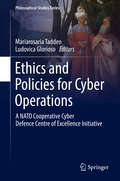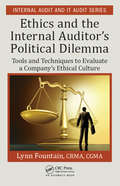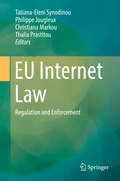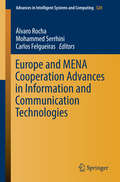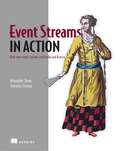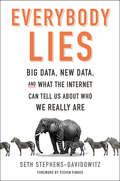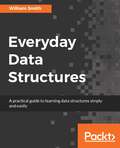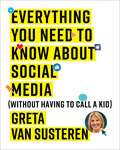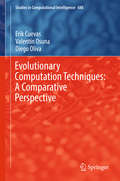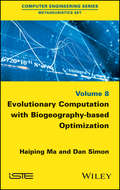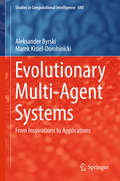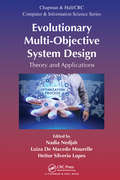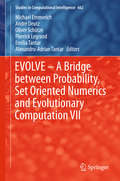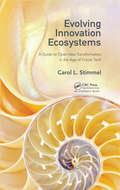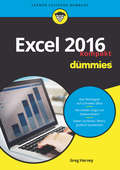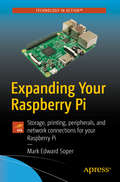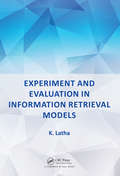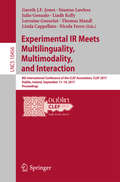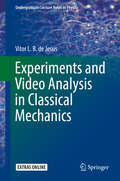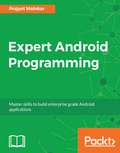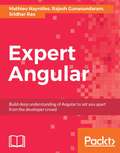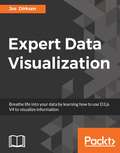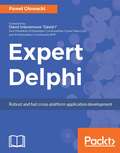- Table View
- List View
Ethics and Policies for Cyber Operations
by Mariarosaria Taddeo Ludovica GloriosoThis book presents 12 essays that focus on the analysis of the problems prompted by cyber operations (COs). It clarifies and discusses the ethical and regulatory problems raised by the deployment of cyber capabilities by a state's army to inflict disruption or damage to an adversary's targets in or through cyberspace. Written by world-leading philosophers, ethicists, policy-makers, and law and military experts, the essays cover such topics as the conceptual novelty of COs and the ethical problems that this engenders; the applicability of existing conceptual and regulatory frameworks to COs deployed in case of conflicts; the definition of deterrence strategies involving COs; and the analysis of models to foster cooperation in managing cyber crises. Each essay is an invited contribution or a revised version of a paper originally presented at the workshop on Ethics and Policies for Cyber Warfare, organized by the NATO Cooperative Cyber Defence Centre of Excellence in collaboration with the University of Oxford. The volume endorses a multi-disciplinary approach, as such it offers a comprehensive overview of the ethical, legal, and policy problems posed by COs and of the different approaches and methods that can be used to solve them. It will appeal to a wide readership, including ethicists, philosophers, military experts, strategy planners, and law- and policy-makers.
Ethics and the Internal Auditor's Political Dilemma: Tools and Techniques to Evaluate a Company's Ethical Culture (Security, Audit and Leadership Series #10)
by Lynn FountainThis book helps auditors understand the reality of performing the internal audit role and the importance of properly managing ethical standards. It provides many examples of ethical conflicts and proposes alternative actions for the internal auditor. Internal auditors are well-schooled on the IIA Standards, but the reality is that the pressure placed on internal auditors related to execution of work and upholding ethical standards can be very difficult. Regardless of best practice or theory, auditors must be personally prepared to manage through issues they run across.
EU Internet Law
by Tatiana-Eleni Synodinou Philippe Jougleux Christiana Markou Thalia PrastitouThis book provides an overview of recent and future legal developments concerning the digital era, to examine the extent to which law has or will further evolve in order to adapt to its new digitalized context. More specifically it focuses on some of the most important legal issues found in areas directly connected with the Internet, such as intellectual property, data protection, consumer law, criminal law and cybercrime, media law and, lastly, the enforcement and application of law. By adopting this horizontal approach, it highlights - on the basis of analysis and commentary of recent and future EU legislation as well as of the latest CJEU and ECtHR case law - the numerous challenges faced by law in this new digital era. This book is of great interest to academics, students, researchers, practitioners and policymakers specializing in Internet law, data protection, intellectual property, consumer law, media law and cybercrime as well as to judges dealing with the application and enforcement of Internet law in practice.
Europe and MENA Cooperation Advances in Information and Communication Technologies
by Álvaro Rocha Mohammed Serrhini Carlos FelgueirasThis book contains a selection of articles from The Europe, Middle East and North Africa Conference on Technology and Security to Support Learning 2016 (EMENA-TSSL'16), held between the 3th and 5th of October at Saidia, Oujda, Morocco. EMENA-TSSL'16 is a global forum for researchers and practitioners to present and discuss recent results and innovations, current trends, professional experiences and challenges in Information & Communication Technologies, and Security to support Learning. The main topics covered are: A) Online Education; B) Emerging Technologies in Education; C) Artificial Intelligence in Education; D) Gamification and Serious games; E) Network & Web Technologies Applications; F) Online experimentation and Virtual Laboratories; G) Multimedia Systems and Applications; H) Security and Privacy; I) Multimedia, Computer Vision and Image Processing; J) Cloud, Big Data Analytics and Applications; K) Human-Computer Interaction; L) Software Systems, Architectures, Applications and Tools; M) Online Languages and Natural Language Processing N) E-content Development, Assessment and Plagiarism; O) Secure E-Learning Development and Auditing; P) Internet of Things and Wireless Sensor Networks.
Event Streams in Action: Real-time event systems with Kafka and Kinesis
by Valentin Crettaz Alexander DeanSummaryEvent Streams in Action is a foundational book introducing the ULP paradigm and presenting techniques to use it effectively in data-rich environments.Purchase of the print book includes a free eBook in PDF, Kindle, and ePub formats from Manning Publications.About the TechnologyMany high-profile applications, like LinkedIn and Netflix, deliver nimble, responsive performance by reacting to user and system events as they occur. In large-scale systems, this requires efficiently monitoring, managing, and reacting to multiple event streams. Tools like Kafka, along with innovative patterns like unified log processing, help create a coherent data processing architecture for event-based applications.About the BookEvent Streams in Action teaches you techniques for aggregating, storing, and processing event streams using the unified log processing pattern. In this hands-on guide, you'll discover important application designs like the lambda architecture, stream aggregation, and event reprocessing. You'll also explore scaling, resiliency, advanced stream patterns, and much more! By the time you're finished, you'll be designing large-scale data-driven applications that are easier to build, deploy, and maintain.What's insideValidating and monitoring event streamsEvent analyticsMethods for event modelingExamples using Apache Kafka and Amazon KinesisAbout the ReaderFor readers with experience coding in Java, Scala, or Python.About the AuthorAlexander Dean developed Snowplow, an open source event processing and analytics platform. Valentin Crettaz is an independent IT consultant with 25 years of experience.Table of ContentsPART 1 - EVENT STREAMS AND UNIFIED LOGSIntroducing event streamsThe unified log 24Event stream processing with Apache KafkaEvent stream processing with Amazon KinesisStateful stream processingPART 2- DATA ENGINEERING WITH STREAMSSchemasArchiving eventsRailway-oriented processingCommandsPART 3 - EVENT ANALYTICSAnalytics-on-readAnalytics-on-write
Everybody Lies: Big Data, New Data, and What the Internet Can Tell Us About Who We Really Are
by Seth Stephens-DavidowitzForeword by Steven PinkerBlending the informed analysis of The Signal and the Noise with the instructive iconoclasm of Think Like a Freak, a fascinating, illuminating, and witty look at what the vast amounts of information now instantly available to us reveals about ourselves and our world—provided we ask the right questions.By the end of on average day in the early twenty-first century, human beings searching the internet will amass eight trillion gigabytes of data. This staggering amount of information—unprecedented in history—can tell us a great deal about who we are—the fears, desires, and behaviors that drive us, and the conscious and unconscious decisions we make. From the profound to the mundane, we can gain astonishing knowledge about the human psyche that less than twenty years ago, seemed unfathomable. Everybody Lies offers fascinating, surprising, and sometimes laugh-out-loud insights into everything from economics to ethics to sports to race to sex, gender and more, all drawn from the world of big data. What percentage of white voters didn’t vote for Barack Obama because he’s black? Does where you go to school effect how successful you are in life? Do parents secretly favor boy children over girls? Do violent films affect the crime rate? Can you beat the stock market? How regularly do we lie about our sex lives and who’s more self-conscious about sex, men or women? Investigating these questions and a host of others, Seth Stephens-Davidowitz offers revelations that can help us understand ourselves and our lives better. Drawing on studies and experiments on how we really live and think, he demonstrates in fascinating and often funny ways the extent to which all the world is indeed a lab. With conclusions ranging from strange-but-true to thought-provoking to disturbing, he explores the power of this digital truth serum and its deeper potential—revealing biases deeply embedded within us, information we can use to change our culture, and the questions we’re afraid to ask that might be essential to our health—both emotional and physical. All of us are touched by big data everyday, and its influence is multiplying. Everybody Lies challenges us to think differently about how we see it and the world.
Everyday Data Structures
by William SmithA practical guide to learning data structures simply and easily About This Book • This book is a very practical, friendly, and useful guide that will help you analyze problems and choose the right data structures for your solution • Learn to recognize data patterns for determining which structures apply to a given problem • Explore the unique rules or "gotchas" that will help you become an excellent programmer Who This Book Is For If you're self-taught programmers in any language who wants to gain a solid understanding of data structures and how to use them to solve real-world problems in your day-to-day development work, then this book is for you. What You Will Learn • A rapid overview of data types, applications for each type, best practices and high-level variations between platforms • Review the most common data structures and build working examples in the languages used for mobile platform software development • Understand advanced data structure concepts such as generic collections, searching and sorting algorithms, and recursion • Learn to use Stacks (LIFO) and queues (FIFO) in your daily application • Add/remove objects and nest arrays and dictionaries within another dictionary and understand why such architecture is often preferred or necessary • Get acquainted with the tree structures such as heap, binary, and graphs, apply them to work • Unleash the power of different sorting techniques such as bubble sort, quick sort, merge sort, insertion sort, and radix sort • Perform searching operations on arrays, heaps, graphs, and binary trees in different languages In Detail If you want to learn different data structures and their real-world applications quickly through practical examples, then Everyday Data Structures is for you. This book can introduce you to new data structures and their potential applications through examples in languages common to mobile software development on the most popular platforms. The examples are presented with real-world concepts using language that everyone will understand. This book is logically divided into two parts; the first one covers the basic data structures that are built into most languages such as Objective-C, C#, Java, and Swift. It will cover detailed analysis of the common data structures such as arrays, lists, stacks, Queues, and heaps, typical applications, and specific concerns for each language. Each chapter will provide in-depth examples in several popular languages based on real-world applications. The second part will cover more advanced data structures such as generic collections, sorting, searching, and recursion and ways to use those structures in everyday applications. Style and approach This is a practical, result-focused guide, which is easy to follow, but also fast-paced and really satisfying with full of examples.
Everything You Need to Know about Social Media: Without Having to Call A Kid
by Greta Van SusterenA simple, step-by-step guide to the major social media platforms—Facebook, Twitter, LinkedIn, Instagram, Snapchat, and more—by former news anchor and media maven Greta Van Susteren.
Evolutionary Computation Techniques: A Comparative Perspective
by Erik Cuevas Valentín Osuna Diego OlivaThis book compares the performance of various evolutionary computation (EC) techniques when they are faced with complex optimization problems extracted from different engineering domains. Particularly focusing on recently developed algorithms, it is designed so that each chapter can be read independently. Several comparisons among EC techniques have been reported in the literature, however, they all suffer from one limitation: their conclusions are based on the performance of popular evolutionary approaches over a set of synthetic functions with exact solutions and well-known behaviors, without considering the application context or including recent developments. In each chapter, a complex engineering optimization problem is posed, and then a particular EC technique is presented as the best choice, according to its search characteristics. Lastly, a set of experiments is conducted in order to compare its performance to other popular EC methods.
Evolutionary Computation with Biogeography-based Optimization
by Dan Simon Haiping MaEvolutionary computation algorithms are employed to minimize functions with large number of variables. Biogeography-based optimization (BBO) is an optimization algorithm that is based on the science of biogeography, which researches the migration patterns of species. These migration paradigms provide the main logic behind BBO. Due to the cross-disciplinary nature of the optimization problems, there is a need to develop multiple approaches to tackle them and to study the theoretical reasoning behind their performance. This manuscript intends to explain the mathematical model of BBO algorithm and its variants created to cope with continuous domain problems (with and without constraints) and combinatorial problems. Due to the cross-disciplinary nature of the optimization problems, there is a need to develop multiple approaches to tackle them and to study the theoretical reasoning behind their performance. This manuscript intends to explain the mathematical model of BBO algorithm and its variants created to cope with continuous domain problems (with and without constraints) and combinatorial problems.
Evolutionary Multi-Agent Systems
by Aleksander Byrski Marek Kisiel-DorohinickiThis book addresses agent-based computing, concentrating in particular on evolutionary multi-agent systems (EMAS), which have been developed since 1996 at the AGH University of Science and Technology in Cracow, Poland. It provides the relevant background information on and a detailed description of this computing paradigm, along with key experimental results. Readers will benefit from the insightful discussion, which primarily concerns the efficient implementation of computing frameworks for developing EMAS and similar computing systems, as well as a detailed formal model. Theoretical deliberations demonstrating that computing with EMAS always helps to find the optimal solution are also included, rounding out the coverage.
Evolutionary Multi-Objective System Design: Theory and Applications (Chapman & Hall/CRC Computer and Information Science Series)
by Nadia Nedjah, Luiza De Macedo Mourelle and Heitor Silverio LopesReal-world engineering problems often require concurrent optimization of several design objectives, which are conflicting in cases. This type of optimization is generally called multi-objective or multi-criterion optimization. The area of research that applies evolutionary methodologies to multi-objective optimization is of special and growing interest. It brings a viable computational solution to many real-world problems. Generally, multi-objective engineering problems do not have a straightforward optimal design. These kinds of problems usually inspire several solutions of equal efficiency, which achieve different trade-offs. Decision makers’ preferences are normally used to select the most adequate design. Such preferences may be dictated before or after the optimization takes place. They may also be introduced interactively at different levels of the optimization process. Multi-objective optimization methods can be subdivided into classical and evolutionary. The classical methods usually aim at a single solution while the evolutionary methods provide a whole set of so-called Pareto-optimal solutions. Evolutionary Multi-Objective System Design: Theory and Applications provides a representation of the state-of-the-art in evolutionary multi-objective optimization research area and related new trends. It reports many innovative designs yielded by the application of such optimization methods. It also presents the application of multi-objective optimization to the following problems: Embrittlement of stainless steel coated electrodes Learning fuzzy rules from imbalanced datasets Combining multi-objective evolutionary algorithms with collective intelligence Fuzzy gain scheduling control Smart placement of roadside units in vehicular networks Combining multi-objective evolutionary algorithms with quasi-simplex local search Design of robust substitution boxes Protein structure prediction problem Core assignment for efficient network-on-chip-based system design
EVOLVE – A Bridge between Probability, Set Oriented Numerics and Evolutionary Computation VII
by Michael Emmerich André Deutz Oliver Schütze Pierrick Legrand Emilia Tantar Alexandru-Adrian TantarThis book comprises nine selected works on numerical and computational methods for solving multiobjective optimization, game theory, and machine learning problems. It provides extended versions of selected papers from various fields of science such as computer science, mathematics and engineering that were presented at EVOLVE 2013 held in July 2013 at Leiden University in the Netherlands. The internationally peer-reviewed papers include original work on important topics in both theory and applications, such as the role of diversity in optimization, statistical approaches to combinatorial optimization, computational game theory, and cell mapping techniques for numerical landscape exploration. Applications focus on aspects including robustness, handling multiple objectives, and complex search spaces in engineering design and computational biology.
Evolving Innovation Ecosystems: A Guide to Open Idea Transformation in the Age of Future Tech
by Carol L. StimmelWhile emerging technologies create massive opportunity, especially for investors and companies that seek more adaptable forms of economic growth than currently available, value is held inert by traditional approaches, patents, and other closed systems. Yet, open data, content, and information may be the key to mass innovation for future technologies, although they bring difficult challenges to private-industry models that depend on the established ideas of intellectual property. <P><P>It is from this foundational observation that OpenXFORM (a blending of the words Open and the engineering abbreviation for Transformation) was developed and is explored and described in this book. The intent of the model design is to synthesize an approach to the process of innovation, inspired by natural systems and human-centric design processes. OpenXFORM describes how an open system of innovation can adapt to the unregulated world of information, data, and content; can decompose its own information to release to the open world; and can discover ways to find the points of synergy among the studied and tested methodologies that put human relationships first. <P><P>This book presents an explicit innovation process that shows how to move from a breakthrough idea through a process that encourages innovative thinkers to test their assumptions, validate hypotheses, and tune and tweak their ideas, not only to drive solutions for users but also to meet the strategic goals of their companies. The anatomy of innovation through OpenXFORM contains the process for moving ideas from a flight of fancy to an explicit concept that is ready to produce.
EXAM CRAM CompTIA A+ 220-901 and 220-902 Practice Questions
by David L. ProwseCompTIA A+ 220-901 and 220-902 Practice Questions Exam Cram CompTIA A+ 220-901 and 220-902 Practice Questions Exam Cram complements any A+ study plan with 640 practice test questions in the book and on the companion site--all supported by complete explanations of every answer. This package's highly realistic questions cover every area of knowledge for both new A+ exams: 220-901 and 220-902. Covers the critical information you'll need to know to score higher on your A+ 220-901 and 220-902 exams! #65533; Features 640 questions, organized to reflect the newest objectives for the A+ exams, so you can easily assess your knowledge of every topic. #65533; Each question includes a detailed answer explanation. #65533; Provides complete coverage of all objectives for the 220-901 and 220-902 A+ exams. COMPANION WEBSITE #65533; Test engine features more than 600 questions from this book in multiple test modes, among other features #65533; Includes 10 real-world scenarios with supporting simulations and videos
Excel 2016 für Dummies kompakt (Für Dummies)
by Greg HarveyBearbeiten und verwalten Sie umfangreiche Tabellen am Computer? Dann kommen Sie um Excel nicht herum. In diesem kompakten Buch lernen Excel-Neulinge und -Umsteiger die aktuellste Version von Excel und die wesentlichen Funktionen in aller Kürze kennen. Fangen Sie ganz einfach an und arbeiten Sie sich zu Diagrammen, Tabellen, Funktionen und Formeln vor. Sie finden in diesem Buch die besten Tipps und Tricks zu Excel, die Ihnen das Arbeiten sehr erleichtern werden.
Expanding Your Raspberry Pi
by Mark Edward SoperGain a deeper understanding of how Raspberry Pi works to get the results you want right in the palm of your hand. This book helps you understand the right connections and software to drive your Raspberry Pi into opening the worlds of programming, electronic experiments, system control, digital imaging, and the Internet of Things to you. You'll discover how to expand your Pi's storage for bigger programs, use its onboard connections to interface with cameras and control devices, printers and scanners. You'll also see how to share information with Windows and Apple computers and mobile devices, and use it away from AC power. You'll be able to turn any HDTV into a media player; stream and share files from desktop and mobile devices; use your Pi for image capture via camera or scanner; and more! Expanding Your Raspberry Pi is your guide to doing almost anything a bigger computer can do - if you're ready for the challenge. What You'll Learn Connect, use, and manage mass storage devices for greater versatility Link with desktop, laptop, and mobile devices using the Pi's built-in Wi-Fi and Bluetooth features Share resources from your Pi with desktop and mobile devices Capture video and still photos with your Pi Who This Book Is For Network administrators: Connect Raspberry Pi devices to other devices on a wired or wireless network for media streaming, file serving, or print serving Teachers: Use Raspberry Pi to teach students how to connect different types of computers and operating systems with each other. IT workers: Use Raspberry Pi with your existing printers, scanners, webcams, and home network
Expelled
by James Patterson Emily RaymondOne viral photo.Four expelled teens.Everyone's a suspect.Theo Foster's Twitter account used to be anonymous--until someone posted a revealing photo that got him expelled. No final grade. No future. No fair.Theo's resigned to a life of misery working at the local mini-mart when a miracle happens: Sasha Ellis speaks to him. Sasha Ellis knows his name. She was also expelled for a crime she didn't commit, and now he has the perfect way to get her attention: find out who set them up.To uncover the truth, Theo has to get close to the suspects: the hacker, the quarterback, the mean girl, the vice principal, and his own best friend. What secrets are they hiding? And how can Theo catch their confessions on camera?
Experiment and Evaluation in Information Retrieval Models
by K. LathaExperiment and Evaluation in Information Retrieval Models explores different algorithms for the application of evolutionary computation to the field of information retrieval (IR). As well as examining existing approaches to resolving some of the problems in this field, results obtained by researchers are critically evaluated in order to give readers a clear view of the topic. In addition, this book covers Algorithmic Solutions to the Problems in Advanced IR Concepts, including Feature Selection for Document Ranking, web page classification and recommendation, Facet Generation for Document Retrieval, Duplication Detection and seeker satisfaction in question answering community Portals. Written with students and researchers in the field on information retrieval in mind, this book is also a useful tool for researchers in the natural and social sciences interested in the latest developments in the fast-moving subject area. Key features: Focusing on recent topics in Information Retrieval research, Experiment and Evaluation in Information Retrieval Models explores the following topics in detail: Searching in social media Using semantic annotations Ranking documents based on Facets Evaluating IR systems offline and online The role of evolutionary computation in IR Document and term clustering, Image retrieval Design of user profiles for IR Web page classification and recommendation Relevance feedback approach for Document and image retrieval
Experimental IR Meets Multilinguality, Multimodality, and Interaction: 8th International Conference of the CLEF Association, CLEF 2017, Dublin, Ireland, September 11–14, 2017, Proceedings (Lecture Notes in Computer Science #10456)
by Gareth J.F. Jones, Séamus Lawless, Julio Gonzalo, Liadh Kelly, Lorraine Goeuriot, Thomas Mandl, Linda Cappellato and Nicola FerroThis book constitutes the refereed proceedings of the 8th International Conference of the CLEF Initiative, CLEF 2017, held in Dublin, Ireland, in September 2017.The 7 full papers and 9 short papers presented together with 6 best of the labs papers were carefully reviewed and selected from 38 submissions. In addition, this volume contains the results of 10 benchmarking labs reporting their year long activities in overview talks and lab sessions. The papers address all aspects of information access in any modality and language and cover a broad range of topics in the field of multilingual and multimodal information access evaluation.
Experiments and Video Analysis in Classical Mechanics (Undergraduate Lecture Notes in Physics)
by Vitor L. B. de JesusThis book is an experimental physics textbook on classical mechanics focusing on the development of experimental skills by means of discussion of different aspects of the experimental setup and the assessment of common issues such as accuracy and graphical representation. The most important topics of an experimental physics course on mechanics are covered and the main concepts are explored in detail. Each chapter didactically connects the experiment and the theoretical models available to explain it. Real data from the proposed experiments are presented and a clear discussion over the theoretical models is given. Special attention is also dedicated to the experimental uncertainty of measurements and graphical representation of the results. In many of the experiments, the application of video analysis is proposed and compared with traditional methods.
Expert Android Programming
by Prajyot MainkarBecome a pro with the latest Android SDK and create state of the art applications for Android. About This Book • Dive deep into Android development with practical hands on examples to help you in each stage. • Develop smart professional grade apps for the latest Android N version and become a pro android developer. • Unclog your development highway by utilising the industry standard best practices techniques. Who This Book Is For This book is for mobile developers having some expertise in building android apps and who wish to now take a leap into building complex app such as Zomato, using latest Android N power of Google. What You Will Learn • Building UI/UX following best industry practices • Development of Zomato Clone • Measure and improve app performance • Improving app using test mechanisms • Bringing the app live on the play store In Detail Android O brings a number of important changes for the users as well as the developers. If you want to create smart android applications which are fast, lightweight and also highly efficient then this is the book that will solve all your problems. You will create a complex enterprise grade app in this book. You will get a quick refresher of the latest android SDK and how to configure your development environment. Then you will move onto creating app layouts, component and module building, creating smart and efficient UIs. The most important part of a modern day app is how real time they are. With this book, you will create a smooth back-end for your app, ensure dynamic and real time communication between different app layers. As we move on, you will learn to leverage the different Android APIs and create an efficient SQLite data layer for your apps. You will implement effective testing techniques to make your app reliable and robust and finally you will learn to deploy it efficiently. The multiple stages of android development will also be simplified by giving you an industry standard set of best practices. Style and approach This book will have a dedicated practical tutorial style approach with focus on professional & enterprise grade android app development. The examples in each chapter will be modular and will also help you to create a complete fully fueatured android app by the end of the book.
Expert Angular
by Sridhar Rao Mathieu Nayrolles Rajesh GunasundaramLearn everything you need to build highly scalable, robust web applications using Angular release 4 About This Book • Apply best practices and design patterns to achieve higher scalability in your Angular applications • Understand the latest features of Angular and create your own components • Get acquainted with powerful, advanced techniques in Angular to build professional web applications Who This Book Is For This book is for JavaScript developers with some prior exposure to Angular, at least through basic examples. We assume that you've got working knowledge of HTML, CSS, and JavaScript. What You Will Learn • Implement asynchronous programming using Angular • Beautify your application with the UI components built to the material design specification • Secure your web application from unauthorized users • Create complex forms, taking full advantage of 2-way data binding • Test your Angular applications using the Jasmine and Protractor frameworks for better efficiency • Learn how to integrate Angular with Bootstrap to create compelling web applications • Use Angular built-in classes to apply animation in your app In Detail Got some experience of Angular under your belt? Want to learn everything about using advanced features for developing websites? This book is everything you need for the deep understanding of Angular that will set you apart from the developer crowd. Angular has introduced a new way to build applications. Creating complex and rich web applications, with a lighter resource footprint, has never been easier or faster. Angular is now at release 4, with significant changes through previous versions. This book has been written and tested for Angular release 4. Angular is a mature technology, and you'll likely have applications built with earlier versions. This book starts by showing you best practices and approaches to migrating your existing Angular applications so that you can be immediately up-to-date. You will take an in-depth look at components and see how to control the user journey in your applications by implementing routing and navigation. You will learn how to work with asynchronous programming by using Observables. To easily build applications that look great, you will learn all about template syntax and how to beautify applications with Material Design. Mastering forms and data binding will further speed up your application development time. Learning about managing services and animations will help you to progressively enhance your applications. Next you'll use native directives to integrate Bootstrap with Angular. You will see the best ways to test your application with the leading options such as Jasmine and Protractor. At the end of the book, you'll learn how to apply design patterns in Angular, and see the benefits they will bring to your development. Style and approach This book provides comprehensive coverage of all aspects of development with Angular. You will learn about all the most powerful Angular concepts, with examples and best practices. This book is everything you need for the deep understanding of Angular that will set you apart from the developer crowd.
Expert Data Visualization
by Jos DirksenBreathe life into your data by learning how to use D3.js V4 to visualize information About This Book • Create complex visualizations powered by D3.js and open data. • Provides an extensive set of visualizations that explore all the functionality provided by D3.js V4. • Shows how to set up an easy–to-use environment to create stunning visualizations. Who This Book Is For The typical target audience of this book is JavaScript developers, designers, and visual artists who have some basic JavaScript programming knowledge and who now want to master pro-level techniques to create interactive data visualizations using web standards which work on desktop as well as mobile devices. What You Will Learn • Learn how D3.js works to declaratively define visualizations. • Create charts from scratch by using SVG and the D3.js APIs • See how to prepare data for easy visualization using D3.js. • Visualize hierarchical data using chart types provided by D3.js • Explore the different options provided by D3.js to visualize linked data such as graphs. • Spice up your visualizations by adding interactivity and animations. • Learn how to use D3.js to visualize and interact with Geo- and Gis-related information sources. • Create visualization by streaming data over WebSockets In Detail Do you want to make sense of your data? Do you want to create interactive charts, data trees, info-graphics, geospatial charts, and maps efficiently? This book is your ideal choice to master interactive data visualization with D3.js V4. The book includes a number of extensive examples that to help you hone your skills with data visualization. Throughout nine chapters these examples will help you acquire a clear practical understanding of the various techniques, tools and functionality provided by D3.js. You will first setup your D3.JS development environment and learn the basic patterns needed to visualize your data. After that you will learn techniques to optimize different processes such as working with selections; animating data transitions; creating graps and charts, integrating external resources (static as well as streaming); visualizing information on maps; working with colors and scales; utilizing the different D3.js APIs; and much more. The book will also guide you through creating custom graphs and visualizations, and show you how to go from the raw data to beautiful visualizations. The extensive examples will include working with complex and realtime data streams, such as seismic data, geospatial data, scientific data, and more. Towards the end of the book, you will learn to add more functionality on top of D3.js by using it with other external libraries and integrating it with Ecmascript 6 and Typescript Style and approach This book will have a real–world, case-study approach, where you will be given data sets from different domains. These data sets will have different visualization goals; some might need 2D or 3D charts, some might need automated workflows, others might require interactive maps. While you fulfill these goals, you will learn different techniques and best practices, which will enable you to perform data visualization tasks on your own
Expert Delphi
by Pawel GlowackiBecome a developer superhero and build stunning cross-platform apps with Delphi About This Book • A one-stop guide on Delphi to help you build cross-platform apps • This book covers important concepts such as the FireMonkey library, shows you how to interact with the Internet of Things, and enables you to integrate with Cloud services • The code is explained in detail with observations on how to create native apps for Ios and Android with a single code base Who This Book Is For If you want to create stunning applications for mobile, desktop, the cloud, and the Internet of Things, then this book is for you. This book is for developers who would like to build native cross-platform apps with a single codebase for iOS and Android. A basic knowledge of Delphi is assumed, although we do cover a primer on the language. What You Will Learn • Understand the basics of Delphi and the FireMonkey application platform as well as the specifics of Android and iOS platforms • Complete complex apps quickly with access to platform features and APIs using a single, easy-to-maintain code base • Work with local data sources, including embedded SQL databases, REST servers, and Backend-as-a-Service providers • Take full advantage of mobile hardware capabilities by working with sensors and Internet of Things gadgets and devices • Integrate with cloud services and data using REST APIs and scalable multi-tier frameworks for outstanding multi-user and social experience • Architect and deploy powerful mobile back-end services and get super-productive by leveraging Delphi IDE agile functionality • Get to know the best practices for writing a high-quality, reliable, and maintainable codebase in the Delphi Object Pascal language In Detail Delphi is the most powerful Object Pascal IDE and component library for cross-platform native app development. It enables building natively compiled, blazingly fast apps for all major platforms including Android, iOS, Windows, Mac, and Linux. If you want to build server-side applications, create web services, and have clear GUIs for your project, then this book is for you. The book begins with a basic primer on Delphi helping you get accustomed to the IDE and the Object Pascal language and will then quickly move on to advanced-level concepts. Through this book, we'll help you understand the architecture of applications and will teach you the important concepts of the FireMonkey library, show you how to build server-side services, and enable you to interact with the Internet of Things. Towards the end, you will learn to integrate your app with various web services and deploy them. By the end of the book, you will be able to build powerful, cross-platform, native apps for iOS and Android with a single code base. Style and approach This book will help you build cross-platform mobile apps with Delphi using a step-by-step approach.
